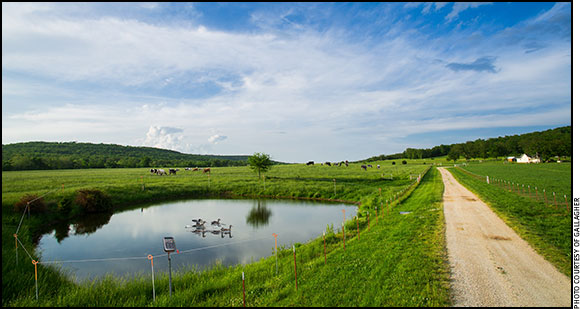MANAGEMENT...

Limiting Livestock Access to Ponds Best for Bass & Bovines
Keeping cattle out of farm ponds keeps the pond and the cattle healthy.
As both a cattleman and manager of one of the country’s largest fish farms, Matt Flynt is responsible for hundreds of cattle, millions of fish, thousands of acres of water and miles of levees in central Arkansas. His livelihood relies on water quality. So when it comes time to let the cows drink, he can’t afford to muddy the waters.
“I’m in the business to raise fish, so I’m definitely not going to do anything with the cattle to jeopardize the water,” says the owner of Fly’n“T” Cattle Co. and manager of Pool Fisheries in Lonoke, Ark. “My situation is unique, but in general, I think it’s a really good idea to fence off the ponds and restrict livestock access.” Read more.
On the Move
Tips on trailing cows and calves to avoid problems.
A common problem during cattle drives is cows and calves getting separated. Some may try to leave the herd and go back to whence they came. The cure for most of these problems is prevention. Chad Cheyney, extension educator at the University of Idaho, offers some thoughts on trailing cows and calves. Read more.
Grazing to Improve Soil Health, Producer Profits
Texas A&M AgriLife researcher leads effort to find optimum management strategies.
Richard Teague might be considered a cowboy of a different kind. He’s not rounding up stray cattle, but rather wrangling the best management practices on ranches to help the cattle and their owners.
Teague, a Texas A&M AgriLife Research ecologist at Vernon, grew up on a farm and knows firsthand there are some unintended consequences from traditional long-standing agricultural practices that might not readily be seen.
“I’m an ecologist and know that for an adequately functioning ecosystem, you have to have good soil function,” Teague said. “Many things we do in industrial agriculture break down the function of soil. The ranchers and farmers we are working with have demonstrated how to increase productivity by improving soil health, manage for decreased inputs, improve the health of their cattle and increase profits.” Read more.
Hay Storage, Forage Management Discussed at Forage Field Day
Expert discusses the costs of wasted hay vs. the costs of building a hay barn.
Producing hay requires both time and expense, but it can lead to unwanted waste if bales are left sitting in the field, according to experts.
To preserve nutritive value and money, there are options that can be implemented to manage unwanted waste, said Larry Redmon, Texas A&M AgriLife Extension Service state forage specialist, College Station.
“A barn can pay for itself in four to six years, according to studies done by our Extension economists,” Redmon said. “Many think they can store hay outside, but when hay costs as much as $120 a ton to produce, can we afford to give up some of that expense? Many of us can’t.” Read more.
Five Tips to Help Your Calves Beat Summer’s Heat
As temperatures rise, watch calves closely for early signs of dehydration.
As summer heats up, you may find yourself spending more time in the pool, enjoying ice-cold drinks and sitting in air conditioning to keep cool. Calves also behave differently in the summer to avoid heat stress. By providing a proper environment and good management, you can help reduce the harm of heat stress on your calves.
“Heat stress in calves causes an increase in respiration rates and body temperature, decreased feed intake, rapid dehydration, and reduced immune system function,” says veterinarian Julian (Skip) Olson, technical services manager for Milk Products. “It is important for the health and well-being of your calves to avoid heat stress.” Read more.

Kris Ringwall
Beef Talk
Take steps to minimize the effects of this year’s drought on next year’s production.
Mother Nature has changed everything — again.
The upper Midwest’s dry to drought conditions have changed stocking rates, challenged pasture rotation schedules, hastened the end-grazing date, and limited cow and calf condition scores. Producers need to work through the present and take steps to minimize the effects of this year’s drought on next year’s production.
By weaning and pregnancy checking early, thin, pregnant cows have a chance to improve condition once the calves are weaned. Move out any open or late-bred cows. Wean the calf early, and pay attention to the markets for a good time for selling the calf. Read more.
Angus Advisor
Click here for August herd management tips from cattle experts across the nation. Advice separated by region.
[Click here to go to the top of the page.]






